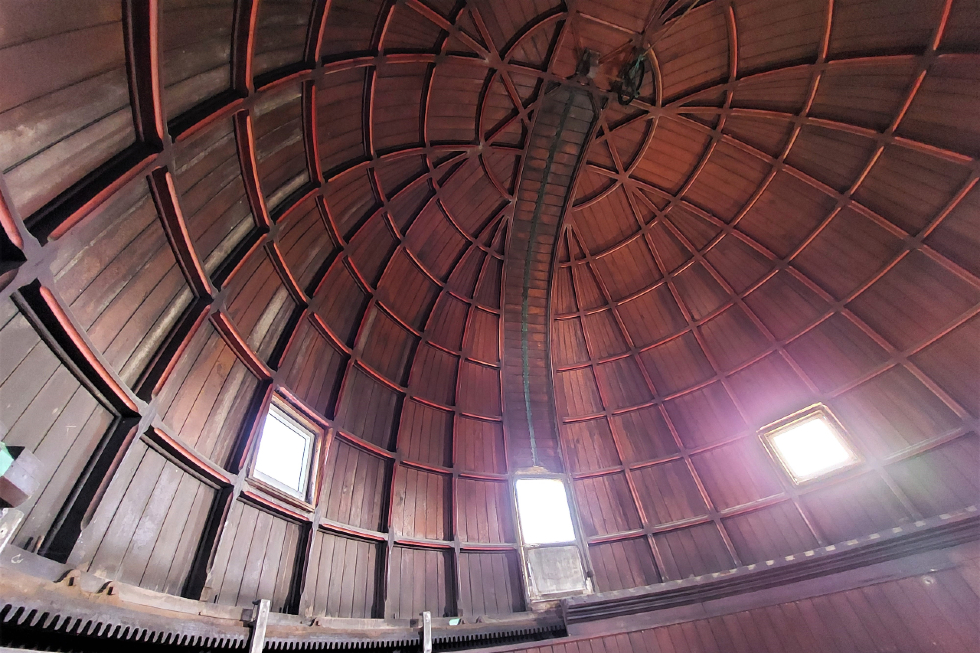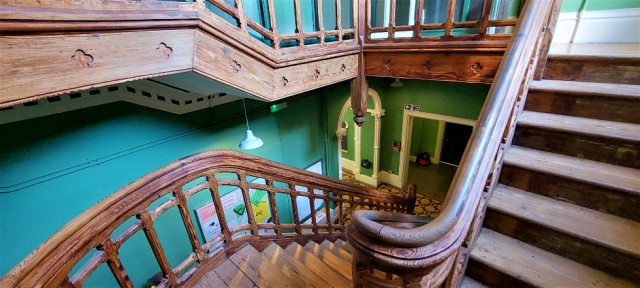Field Trip: Bidston Observatory Artistic Research Centre – Bringing Forth Other Worlds

“One can use art to create new instruments and different spells.” Mathilde Grandjean takes a trip back to the future to visit the repurposed Bidston Observatory in Birkenhead…
Edward Clive’s morning brew is sometimes accompanied by strangers’ big-eyed faces pressed up against the glass of his window at the Bidston Observatory. Though it can be startling, he understands people’s wonder and curiosity at the incongruous, almost alien-looking building. Fort-like, twin-domed, partly hidden by thick woodland, and sitting at one of the highest points of the Wirral peninsula, there certainly is a magnetic aura about the place. Walk through its doors, and you will soon find the more time you spend there, the more you are subject to its pull.
“There are lots of quirks to the building,” says Edward, a furniture designer by profession who, along with a small team, runs the Bidston Observatory Artistic Research Centre – the site’s current occupants. He told me of those oddities as we toured the site: how it is surrounded by a deep moat invisible from the outside, built as a vibrational buffer – originally against disturbances caused to the telescopes by horse-drawn carriages. Or how it doesn’t rest on any foundation; it was dug into the hill when its basements were constructed first, and the excavated sandstone was used to assemble the aboveground structure. “Like the building is rising out of its own material,” Edward said.
Nearly 150 years old, in its heyday the observatory was at the heart of outstanding scientific research; its timekeeping, tidal prediction, and meteorological works formed the internal clock of the British Empire. Yet it isn’t the famous local landmark you might expect. While some history buffs come a long way to visit the site – like the American, self-declared “true fan” who turned out to be Ed’s fierce rival bidder on eBay auctions for old postcards of the building – most people just stroll past it on their Sunday afternoon walks, idly wondering what, if anything, is going on there.
In fact, most people across the region have either forgotten about this place or have never heard of it. Those aware of its existence, however, have long feared for its future after its previous occupants, the Proudman Oceanographic Laboratory, abandoned the premises in 2004. It was then sold to a local developer who could never figure out what to do with the unusual structure.

Enter Edward and his wife, artist and trauma therapist Fiona James, who first came across the building in 2016. Following a stay with a collective of artists called the Performance Arts Forum, which transformed an old monastery in the French village of St Erme into a communal study and living site, the pair were inspired to import a similar model to the UK. They had been looking all over the country for a site to reproduce the experiment – and their search stopped at Bidston. Back then, the observatory had been intermittently vacant for more than a decade. With its windows boarded up, its revolving domes paralysed by rust, clogged drains, hollow sub-basements and walls munched on by rewilding vegetation, it looked a perfect setting for some creepy urbex vlog or secret séance.
“We couldn’t understand how a building with that significant a history had fallen into such disrepair,” said Edward. “But I remember thinking how perfect it would be to house the project, both practically and contextually.” Subsequently, a group of researchers, artists, and performers from all over the UK joined with Edward and Fiona to buy the property and jump-start the project. It took three years of heavy renovation work and administrative wrangling with local authorities and developers until the reimagined centre could finally open its doors in 2019.
However complicated that process, the concept is simple. A communal study site run by a small team of part-time stewards, BOARC seeks to provide a wide range of practitioners, professional and otherwise, with the space and time they can dedicate to their work. Groups and individuals with a project can stay at the observatory from two nights to a month, paying a nightly fee chosen from a sliding scale depending on what they feel they can afford. No laborious application procedure is required: an email suffices. No expectation of productivity either. Stuck poets, painting beginners, geography students, actors, sound artists, therapists, amateur historians, and other itinerant readers are all welcome to form transient communities at the observatory. The only conditions for the stay are to look after the shared spaces and be mindful of others’ boundaries within them.
“I think there’s meaningful work that happens when people from completely different disciplines bump into each other in the kitchen and have a chat,” said Ed. “To access spaces, tools, and meet different people is a really powerful thing.”
“We know that artistic research as a term is in and of itself a barrier,” said Kym Ward, co-founder and director of the project. “But we stuck to it because it speaks to a process rather than an exhibition. We’re interested in the application, the experimentation and the engineering, in relation to the political and ideological – and how they can’t be separated.”
The Engineering of Spells
One way BOARC carries out this effort is through an ongoing project called the Heritage Education Centre Space (HECS), which encourages artists to foster conversations around the observatory as a former instrument of colonial growth. Compiling archival material, scientific descriptions, and artistic contributions on a wiki, its name’s acronym phonetically evokes “hex” – or spell: an element of language with the power to manifest a certain reality upon utterance. That’s because HECS looks at how the design and use of certain scientific instruments have altered our understanding of ourselves, each other, and the world.
Take time, for instance. Time as we know it today: linear, chronological, split-second accurate. This is a product of 19th-century time-keeping sciences, of observing planets and stars using telescopes and imaginary lines called meridians. Time was key to the success of Britain’s maritime industry, serving as a referent to map out the surface of the earth, regulate international trade, and accelerate the expansion of British authority over foreign territories. Time isn’t just data – it’s a global software with meaningful implications. And, like every software, it relies on physical components to operate and exist: the hardware – observatories like Bidston’s.
“That level of architectural innovation has an effect on the bodies and psyches of the people who are citizens,” said Kym, who also conducts research into the observatory’s history. “This is how you can tell colonialism exists on a molecular level, on an organic level, and on a psychic level.”
To challenge this reality and bring forth other worlds, one can use art to create new instruments and different software/spells – to enable other ways of knowing and living. Within HECS, this work of dissident worldbuilding is nothing if not plural. Like threads of a tapestry that’s never quite complete, it’s picked up, undone, and redone by the variously experienced hands of those passing by and through.
“Community is only as strong as the people who tell its history and folklore,” said Kym. “That, I guess, is the spell in HECS. It happens or it doesn’t – it depends if people want to tell it. But whatever spell it would be, it would come through the voices of many, not just one.”
The Quieting
In January last year, during my first stay at the observatory, I met Maeve, a sound artist and one of those voices. With a background in punk, experimental, and DIY music, she contributes to the observatory’s very own radio show, Domes FM, which broadcasts on Wednesday evenings.
Along with other poets and performers, Maeve and I had joined in the Spellcraft & Poetry Weekend at the observatory. She launched the festivities on the Friday evening with her first performance as Quieting – her then-new stage name. Set in the eastern dome, the performance consisted of an hour-long composition called Gust Compression.
“I think a lot about systems and the relatedness of everything,” said Maeve, for whom sound is a guiding tool, like a compass in the body, helping her navigate the networks of ceaseless interaction that make up the fabric of the world.
“I think it’s absolutely stunning how everything is held together. But then, how do we locate ourselves within this universe? One way I’ve found is through echoes, reverbs, and repetitions. It’s using sound relationally to look at time – and how we situate ourselves.”
Gust Compression looks at time through sounds carried on the wind. Using records of the observatory’s weather station from December 1905, she translated two-hours’ worth of wind speed, direction, and pressure data points into musical notes – raising the ghosts of past windscapes. Combined with these are live sounds captured inside the weather cabin and on its roof; where looms the metal skeleton of a disused instrument for measuring the speed, force, and direction of the wind called an anemometer – yet another spectre reminding us of the building’s original purpose. Maeve then made a counterpoint melody from the predictive wind data from a week after the live recording. The final composition is an interchange of wind gusts over a 24-hour period – a day’s worth of past, present, and future sounds folding into one another. A musical time paradox, and a reflection of the site itself.

This was Maeve’s way of partaking in what is known within HECS as the “palliative care” of Bidston Observatory – literally caring for something that is dying. Since the opening of BOARC, artists have been theorising and practising means to care for the building and instruments so that the imperialist meanings – the spells – attached to them deteriorate and pass, making space for change. Other histories, other presents, other futures. These practices call, not for a forsaking of, but for a creative reappropriation of the instruments that enabled colonialism.
“It’s about not putting things on plinths and behind glass but letting them be where they were and letting them degenerate,” said Maeve. “It’s not being careless with stuff, but letting it be what it is until it isn’t anymore.”
Asked why she chose the name Quieting, Maeve replied she was not sure – that she didn’t, in fact, choose the name. That she let a book fall open, pointed her finger at the page with her eyes closed, and there it was: quieting. But I was puzzled by a musician’s embrace of silence. Then Maeve read a line from Pauline Oliveros’ Sonic Meditations: “Take a walk at night. Walk so silently that the bottoms of your feet become ears.” And something unravelled from that moving image: the quieting. This, too, could be about relatedness and interdependence. Sounds need silence to carry. Things sometimes deteriorate and pass before they can transform. The observatory is a remnant of Empire – a living dead. But by engaging with its passing, the artists of BOARC have turned it into an incubation vat, too. A place where the gentle quieting of past clamours enables different voices to emerge. Voices that can spell out the words for a different world.
Words and images, Mathilde Grandjean
Bidston Observatory Artistic Research Centre, Wilding Way, Birkenhead, Prenton CH43 7RA
Find out more about BOARC, book a tour, or stay and use the facilities for research or studies





